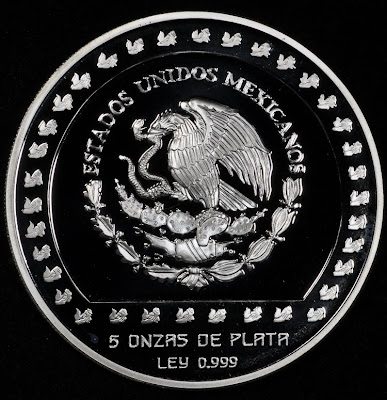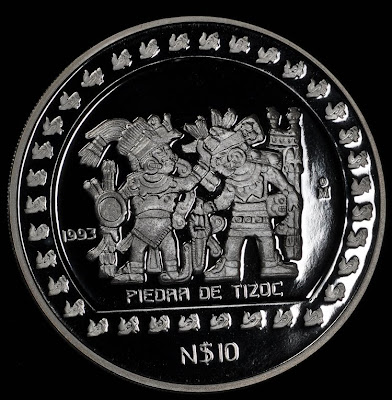 |
| 5-ounce silver coins |
 |
| Mexican commemorative coin 10 Nuevo Pesos Tizoc Stone |
Mexican Silver commemorative coin 10 Nuevo Pesos 1992 nominal value (5 Onzas) - 5 Troy Ounces silver coin, Pre-Columbian Coin Program - Aztec collection Piedra de Tizoc - Stone of Tizoc.
This enormous monolith was discovered at the Templo Mayor and celebrates the victories of Tizoc, Governor of the Aztec Empire. It also symbolizes the ritual of the change of powers from Tizoc to his brother Ahuizotl. Ahuizotl was Tizoc's successor in the Aztec Empire in 1486. Precious metal content is 5 troy oz. of pure (999 fine) silver.
Stone of Tizoc
The Stone of Tizoc, Tizoc Stone or Sacrificial Stone is a large, round, carved Aztec stone, rediscovered on 17 December 1791. It is thought to have been a quauhxicalli, in which the hearts of victims of sacrifice were placed.
The stone is made out of Basalt and ranged from 6 feet in diameter and 4 feet wide.
The stone shows depictions of Texcatlipoca, a major Aztec god, holding the patron gods of other places by the hair. Aztec glyphs give the name of the conquered place, which may have already been conquered, or is considered divinely ordained to be conquered. One of the figures, however, is identified as Tizoc, the Aztec Emperor from 1481 to 1486, who is dressed in the costume of the god Huitzilopochtli. This has led to the stone's association with Tizoc. The stone also depicts the stars at the top rim, emphasizing the heavens and triangular points at the bottom edge represent the earth. The warriors carved into the stone are holding the hair of their enemies gods, which represented submission and defeat in the Aztec culture.
The Stone of Tizoc may have been used as a means of sacrifice or for the use of mock battles between a group of warriors and the victim, who was tied to the stone and given a feathery club while the warriors had sharp swords or clubs. The importance of the Stone of Tizoc is that it was used during the human sacrifices, which Tizoc the emperor wanted glorified through his name.
Tizoc was the seventh emperor of the Tenochtitlán empire after his brother,Axayacatl, died in 1481. The Stone depicts Tizoc's image all over the stone; this was a way to glorify Tizoc's reign despite the many failed battles and military strategies. The Stone of Tizoc has become a staple of Aztec history along with the Aztec Calendar Stone. The Aztec sacrifice was held at the top of temples on specially chosen mountains such as Tenochtitlan,Texcoco, and Tlacopan in which priests had the victims tied to a large, flat stone and then proceeded to cut their hearts out, lifting it up to the sun as an offering. The bodies were either thrown down the temple stairs or the heads were impaled on a rack, also known as a tzompantli.
Sacrifices had begun in the Aztec culture as a form of worship to the gods that demanded payment for creating humanity. The capital of the Aztecs, Tenochtitlan, held thousands of sacrifices which involved men, women, and children.
Sacrifices were held to honor the gods such as: Huitzilopochtli, the god of sacrifice and war, Tlaloc, the god of rain and fertility, Tezcatlipoca, the chief god of the Aztecs, and Quetzalcoatl, the god of education, priesthood, and civilization.
The stone is currently in the National Museum of Anthropology in Mexico City.